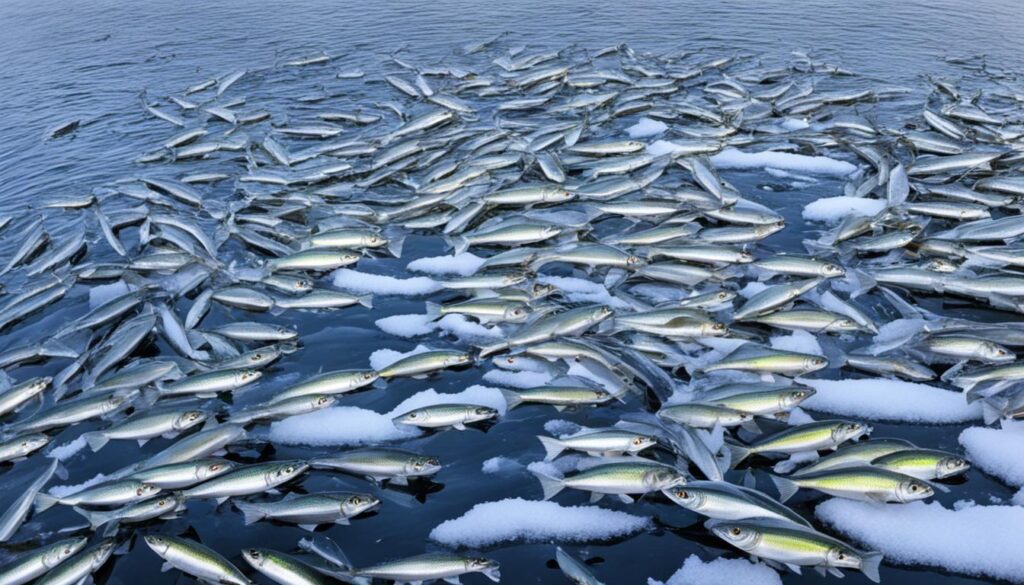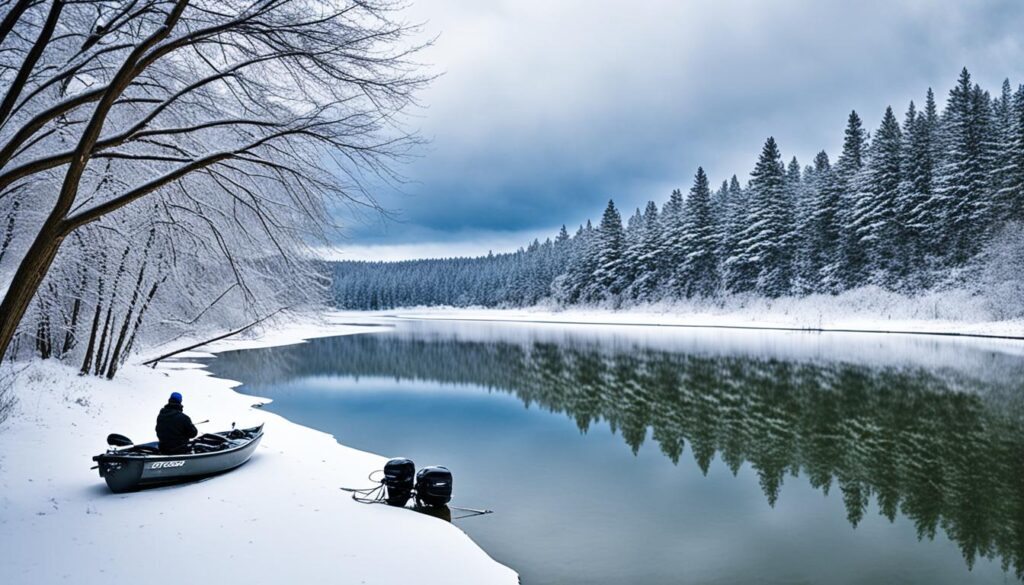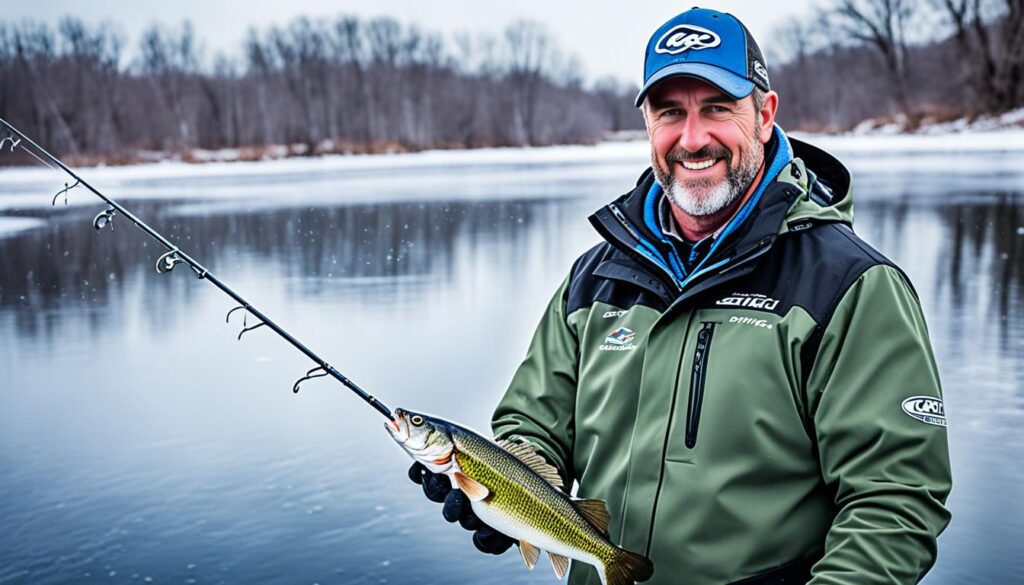Winter bass fishing can be challenging, but co-anglers can increase their chances of success with the proper techniques. This guide will explore various strategies and tips for catching more bass during the winter season.
Angler’s Essentials:
- Utilize repeated casts to irritate winter bass and provoke bites.
- Try using moving baits like crankbaits and buzzbaits to attract bass in cold water.
- Fishing with jerkbaits can be highly effective in triggering strikes from lethargic bass.
- Consider removing the weight peg from Texas rigs for a slower, more natural fall.
- Target transition banks to find stable conditions for winter bass.
Maximize Your Effectiveness with Repeated Casts
When it comes to winter bass fishing, repeated casts can be a game-changer. Winter bass are tightly nestled against cover, making them predictable to locate. However, their slower metabolism and cold water make them less likely to strike. By using repeated casts, you can irritate these bass enough to provoke a bite.
Co-anglers should use moving baits such as crankbaits, spinnerbaits, or ChatterBaits to entice bass. By running these baits down the outside edge of the cover multiple times, you increase your chances of triggering strikes from winter bass.
“Winter bass fishing is all about persistence and finding the right presentation. Repeated casts can make all the difference in enticing those sluggish bass to bite.”
The Key to Success: Targeting Predictable Bass
Winter bass tend to position themselves tightly against cover, such as submerged logs, vegetation, or rock piles, in search of warmth and security. This behavior makes them easier to locate compared to other seasons. However, their sluggishness and decreased feeding activity pose challenges for co-anglers.
To maximize your effectiveness, it’s important to target these predictable bass with repeated casts. By presenting your bait multiple times, you increase the chances of irritating the bass and triggering a strike.
One effective tactic is to cast parallel to the edge of the cover and retrieve your bait back along its outer edge. This strategy allows you to cover the maximum amount of water and increase your chances of encountering a bass.
Choosing the Right Baits for Repeated Casts
When it comes to repeated casts, it’s crucial to select the right baits that can effectively entice winter bass. Here are a few bait options that have proven to be effective:
- Crankbaits: These lures create a lifelike wobbling action that mimics a wounded baitfish, making them a popular choice for winter bass fishing. Choose crankbaits that dive to the appropriate depth to target the bass’s location in the water column.
- Spinnerbaits: Spinnerbaits can be effective tools for covering water quickly and triggering reaction strikes from winter bass. Opt for spinnerbaits with smaller blades and slower retrieves to match the fish’s lethargic nature.
- ChatterBaits: ChatterBaits are versatile lures that combine the vibration of a crankbait with the flash of a spinnerbait. Their unique action and enticing qualities make them a great choice for repeated casts.
With these bait options, you’ll have the confidence to make repeated casts, cover more water, and increase your chances of landing those elusive winter bass. Remember, patience and persistence are key to success!
| Bait | Description |
|---|---|
| Crankbaits | Lifelike wobbling action mimicking wounded baitfish |
| Spinnerbaits | Rapidly covering water and triggering reaction strikes |
| ChatterBaits | Combining vibration and flash for increased enticement |
Remember, mastering the art of repeated casts takes practice and a keen understanding of bass behavior. Embrace the challenge of winter bass fishing, use the right techniques, and you’ll increase your chances of landing that trophy bass.
Unlock the Power of Buzzbaits in Cold Water
Buzzbaits are an underutilized bait for winter bass fishing. While they may not result in a lot of bites, they can attract big fish. Co-anglers should not be afraid to try a black buzzbait in cold water, as it offers a different presentation and targets a different population of bass. Patience is key, as it may take time to get a bite.
When it comes to winter bass fishing, using buzzbaits can be a game-changer. These unique lures create a disturbance on the water’s surface, imitating the movement of a struggling baitfish. This action can trigger the predatory instincts of bass, especially in colder water conditions.
One of the reasons buzzbaits are effective in cold water is because they stand out from other traditional winter bass fishing techniques. Most anglers opt for slow-moving lures or finesse presentations, but a buzzbait offers a more aggressive approach that can entice even inactive bass to strike.
Co-anglers should consider using a black buzzbait in cold water. The contrast against the cold, clear backdrop can make the buzzbait more visible and attractive to bass. Additionally, the black color can mimic the appearance of a dying or injured baitfish, which bass are more likely to target during the winter months.
It’s important to have patience when using buzzbaits in cold water. Unlike some other bass fishing techniques that may yield immediate results, buzzbaits often require more time and perseverance. The erratic and noisy action of the buzzbait can draw curious bass to investigate, but they may need some extra convincing to bite.
Remember, winter bass fishing requires adaptability and experimentation. Don’t be afraid to try different retrieves and speed variations with your buzzbait to find what triggers the best response. Keep in mind that every fishing spot and situation is unique, so be willing to adjust your techniques accordingly.
Capturing the true power of buzzbaits in cold water can lead to some impressive catches. Don’t overlook this versatile and exciting bait when planning your winter bass fishing outings.
Catch More Bass with Jerkbaits
Fishing with jerkbaits can be highly effective in winter. While some anglers may be fishing too fast, co-anglers can use jerkbaits behind them to trigger strikes from lethargic bass. Simple color choices like shiny or white jerkbaits can work well, and a slow, deliberate presentation is crucial.
When using jerkbaits, it’s important to mimic the movements of injured baitfish, enticing bass to strike. The erratic action and suspending nature of jerkbaits make them irresistible to winter bass.
“Jerkbaits are a go-to lure for me during the winter months. Their lifelike appearance and subtle movements can fool even the most finicky bass.” – Pro Angler, Jack Thompson
Here are some essential tips to maximize your success with jerkbaits:
- Vary Your Retrieves: Experiment with different retrieve speeds, pauses, and twitches to determine what triggers the most strikes. Sometimes, a long pause followed by a quick jerk can entice a hesitant bass to commit.
- Pay Attention to Water Temperature: Bass behavior can vary depending on the temperature. In colder water, slow down your presentation and focus on working the bait in the strike zone for longer durations.
- Match the Hatch: Pay attention to the size and color of the baitfish in the area and select jerkbaits that closely resemble them. For example, during winter, fish may be feeding on smaller baitfish, so opt for downsized jerkbaits.
- Use Fluorocarbon Line: Fluorocarbon line has less stretch and is more invisible underwater, increasing your chances of getting a solid hookset. Use a line between 8 and 12-pound test for optimal results.
Remember, patience is key when fishing with jerkbaits. Take your time, experiment with different techniques, and be persistent. With practice, you’ll become more proficient at triggering strikes from winter bass.
Check out this stunning image of a bass striking a jerkbait:

Remove the Weight Peg for Texas Rigs
When it comes to bass fishing, Texas rigs are a popular choice among anglers all year round. However, co-anglers can take their success to the next level by employing a simple modification – removing the weight peg from their lightweight Texas rigs. This small adjustment can have a significant impact on attracting winter bass.
By removing the weight peg, the bait is allowed to have a slower and more natural fall, mimicking the natural movements of prey in the water. As winter bass tend to be less active and more cautious, this subtle change in presentation can make your offering more irresistible to them.
For optimal results, consider using baits such as Zoom Zlinkys, Zoom Ultravibe Speed Worms, or X Zone Adrenaline Bugs with an 1/8-ounce tungsten weight on 15-pound fluorocarbon line. These combinations provide the right balance of weight and action to entice winter bass into biting.
| Bait | Weight | Line |
|---|---|---|
| Zoom Zlinkys | 1/8 ounce | 15-pound fluorocarbon |
| Zoom Ultravibe Speed Worms | 1/8 ounce | 15-pound fluorocarbon |
| X Zone Adrenaline Bugs | 1/8 ounce | 15-pound fluorocarbon |
By implementing this adjustment to your Texas rig setup, you’ll be able to present your bait in a way that resembles natural prey, increasing your chances of enticing winter bass to strike. Remember, adapting your techniques to the specific conditions of winter bass fishing is key to improving your success rate.
Experiment with different bait options, weights, and line strengths to find the combination that works best for you. The goal is to create a presentation that is irresistible to winter bass. With a slower and more natural fall, your Texas rig will become an enticing meal that no winter bass can resist.
The Importance of Transition Banks for Winter Bass
Transition banks, where different types of structure or depth changes occur, are crucial areas to target in winter bass fishing. These locations offer bass the stable conditions they need during the colder months. Anglers should focus their efforts on these areas and adapt their strategies to match the bass’s winter behavior. Slower, more deliberate techniques like slow dragging, dead sticking, or slight twitching with soft plastics can be effective in triggering strikes from lethargic bass.
To better understand the significance of transition banks, let’s take a closer look at their characteristics:
| Characteristics of Transition Banks | Why They are Important |
|---|---|
| • Changes in structure or depth | • Provides a stable environment for bass during colder months |
| • Suitable habitat for bass to transition between different areas | • Allows bass to adjust to changing conditions and locate prey |
| • Variations in vegetation, rocks, or submerged trees | • Offers cover and ambush points for bass to wait for prey |
Transition banks are a magnet for winter bass, providing them with the comfort and opportunity they need to survive and feed. When targeting these areas, co-anglers should employ specific techniques that entice sluggish bass into striking:
- Slow dragging: Drag soft plastic baits along the transition bank, imitating injured or slow-moving prey.
- Dead sticking: Allow soft plastic baits to remain motionless for extended periods, enticing bass with an easy meal.
- Slight twitching: Give soft plastic baits tiny twitches or subtle movements to imitate the movement of a dying or vulnerable prey.
Fishing Quote:
“Fishing is much more than fish. It is the great occasion when we may return to the fine simplicity of our forefathers.” — Herbert Hoover.

With the knowledge of transition banks and the proper techniques, co-anglers can increase their chances of success in winter bass fishing. Anglers can entice lethargic bass into striking by targeting these areas and using slow and deliberate presentations. Patience and adaptability are key when fishing transition banks in the winter.
Be Patient and Persistent in Winter Bass Fishing
Winter bass fishing can be a test of both skill and patience. With colder water temperatures, bass become less active and are less likely to feed aggressively. However, the rewards can be significant, as the bass that are caught during the winter months often tend to be of good size.
When embarking on a winter bass fishing expedition, it is crucial for anglers to adopt a slower pace and approach. This means taking the time to thoroughly work an area before moving on, as bass may require more coaxing to strike in the colder conditions. Remember, patience is key.
One essential aspect of winter bass fishing is being observant. Pay attention to subtle changes in the environment and water conditions, as they can provide valuable clues about bass behavior and potential hot spots. A slight variation in water temperature or the presence of baitfish can lead you to a successful fishing spot.
“In winter bass fishing, it’s all about perseverance and staying dedicated to the task. The more time you spend on the water, the greater your chances of success.” – Experienced Angler
Remember, winter bass fishing is a game of persistence. Even if the bites are slow, stay focused and continue to implement your bass fishing techniques. By remaining patient and persistent, you increase your likelihood of landing that coveted trophy bass.
Keep in mind that winter bass fishing may require adjusting your strategy and experimenting with different techniques. It’s important to adapt to the conditions and be open to trying new approaches. What works in the warmer months may not necessarily yield the same results during the winter.
So, embrace the challenge and enjoy the unique experience that winter bass fishing offers. With the right mindset, patience, and persistence, you can make the most out of your winter fishing adventures.

Introducing Obee Fishing Co.’s Game-Changing Soft Plastic Baits
When it comes to winter bass fishing, having the right baits can make all the difference. That’s why Obee Fishing Co. has developed two exceptional soft plastic baits that are designed to maximize your success during the colder months. Meet the Obee 3″ Ned Stick and Obee 6″ Finesse Worm, game-changers in the world of winter bass fishing.
These soft plastic baits from Obee Fishing Co. are carefully crafted to provide a slow and finesse presentation that perfectly mimics the movement of easy prey. The Ned Stick is a versatile option, offering a natural-looking profile that appeals to a wide range of bass. On the other hand, the Finesse Worm is specifically designed for targeting bigger bass, with its larger size and irresistible action.
Quality is a top priority for Obee Fishing Co. Both the Ned Stick and Finesse Worm are hand-poured in the USA using durable, high-grade materials that ensure longevity and effectiveness. So you can fish confidently knowing that these baits will withstand the rigors of winter bass fishing.
Whether you’re an experienced angler looking to enhance your winter bass fishing game or a novice seeking the right baits to get started, Obee Fishing Co.’s soft plastic baits are a game-changer. Try them out on your next fishing trip and experience the difference they can make in your success.
Conclusion
Winter bass fishing can be a challenging endeavor, but with the right techniques, co-anglers can greatly increase their chances of success. Through strategies like repeated casts, utilizing buzzbaits and jerkbaits, and adapting their approach to the conditions, co-anglers can enhance their winter bass fishing experience.
Patience and persistence are crucial virtues during winter bass fishing. Understanding that bass activity is reduced in colder water temperatures, co-anglers should adopt a slower pace, thoroughly working each area before moving on. By remaining observant of subtle changes in the environment and water conditions, co-anglers can maximize their effectiveness and identify potential hot spots.
Equipping yourself with the right gear is also essential. Obee Fishing Co.’s soft plastic baits, such as the versatile Obee 3″ Ned Stick and the larger Obee 6″ Finesse Worm, are designed to provide the slow, finesse presentations that mimic easy prey. Hand-poured in the USA from durable, high-grade materials, these baits are game-changers for winter bass fishing. Embrace the unique opportunities that winter bass fishing offers and enjoy it to the fullest extent while on the water.
FAQ
What are some effective techniques for winter bass fishing as a co-angler?
As a co-angler, you can maximize your chances of catching winter bass by using techniques like repeated casts, fishing with moving baits, and adapting your strategies to the bass’s winter behavior.
How can repeated casts help in catching winter bass?
Repeated casts can irritate bass enough to provoke a bite. By running moving baits like crankbaits and spinnerbaits down the outside edge of cover multiple times, you can entice bass to strike.
Are buzzbaits effective for winter bass fishing?
Yes, buzzbaits are an underutilized bait for winter bass fishing. While they may not result in a lot of bites, they can attract big fish. Don’t be afraid to try a black buzzbait in cold water, as it offers a different presentation and targets a different population of bass.
How can jerkbaits help in catching winter bass?
Jerkbaits can be highly effective in winter. Use them behind fast-moving anglers to trigger strikes from lethargic bass. Shiny or white jerkbaits with a slow, deliberate presentation can work well.
Should I remove weight pegs from Texas rigs for winter bass fishing?
Yes, removing the weight peg from lightweight Texas rigs allows the bait to have a slower and more natural fall, making it more appealing to winter bass. Baits like Zoom Zlinkys, Zoom Ultravibe Speed Worms, or X Zone Adrenaline Bugs with an 1/8-ounce tungsten weight on 15-pound fluorocarbon can yield great results.
Why are transition banks important for winter bass fishing?
Transition banks, where different types of structure or depth changes occur, are crucial areas to target in winter bass fishing. These locations offer bass the stable conditions they need during the colder months. Slow dragging, dead sticking, or slight twitching with soft plastics can be effective techniques in triggering strikes from lethargic bass.
What should I keep in mind when winter bass fishing?
Winter bass fishing requires patience and persistence. Bass are less active in colder water temperatures, so a slower pace of fishing is necessary. Observing subtle changes in the environment and water conditions can provide clues to bass behavior and potential hot spots.
What soft plastic baits are recommended for winter bass fishing?
Obee Fishing Co. offers two essential soft plastic baits for winter bass fishing: the Obee 3″ Ned Stick and Obee 6″ Finesse Worm. These baits are designed for slow, finesse presentations that mimic the movement of easy prey. They are hand-poured in the USA and made from durable, high-grade materials.
How can Obee Fishing Co.’s soft plastic baits enhance winter bass fishing?
Obee Fishing Co.’s soft plastic baits, such as the Ned Stick and Finesse Worm, are designed to maximize your effectiveness in winter bass fishing. Their slow, finesse presentation and natural-looking design can entice winter bass to bite.
What are the key takeaways for winter bass fishing techniques?
The key takeaways for winter bass fishing techniques are to use repeated casts, explore the power of buzzbaits, catch more bass with jerkbaits, remove the weight peg for Texas rigs, target transition banks, be patient and persistent, and consider using Obee Fishing Co.’s soft plastic baits. Embrace the unique opportunities that winter bass fishing provides and enjoy the experience on the water.
